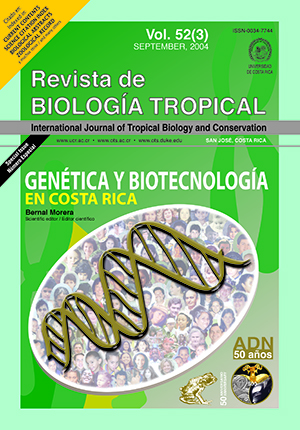Resumen
Previamente se había identificado un extracto crudo a partir de Chamaecrista nictitans (Fabaceae) con actividad antiviral contra el virus herpes simplex. Los objetivos de esta investigación fueron determinar el paso en el ciclo de replicación del herpes simplex inhibidos por el extracto y caracterizar la naturaleza química de dicho extracto. El extracto crudo de la planta se obtuvo con una mezcla de diclorometano/metanol y fraccionado, utilizando la guía de un bioensayo, mediante cromatografía preparativa de capa fina y cromatografía en columna. Los ensayos se llevaron a cabo en monocapas de células Vero. La actividad antiviral exhibida por el extracto fue determinada mediante la inhibi-ción total del efecto citopático después de tres días de incu-bación. La concentración máxima de la fracción positiva que no presentó citotoxicidad fue 200 μg/ml. Se utilizaron técnicas inmunoquímicas y de inmunofluorescencia para elucidar el mecanismo antiviral ejercido por el extracto; con este propósito, se infectaron células Vero con el virus herpes simplex y se determinó la producción de proteínas virales a diferentes tiempos después de la infección. Se detectó la producción de una proteína de aproximadamente 60kDa a las 2 hr y 8 hr luego de la infección; sin embargo no se detectó producción de ningún tipo de proteína tardía, hecho correlacionado con la ausencia de efecto citopático a las 24 hr. Este resultado indica que el extracto actúa intra-celularmente siendo capaz de inhibir la transcripción secun-daria. Sin embargo, el extracto permite la transcripción y traducción de proteínas tempranas. Estos resultados fueron confirmados mediante inmunofluorescencia. En células control no tratadas con el extracto, se observó una fuerte señal fluorescente acompañada de la aparición del efecto citopático característico 24 hr después de la infección con el virus herpes simplex. Por el contrario, células en presen-cia de acyclovir o del extracto desarrollaron un patrón muy discreto de inmunofluorescencia sin presencia de efecto citopático. Se realizaron adicionalmente ensayos de neutra-lización utilizando preincubaciones con un antisuero espe-cífico contra herpes simplex 1, 200 μg/ml del extracto o 20 μg/ml de acyclovir. Solamente el virus tratado con acyclo-vir fue capaz de producir un efecto citopático, mientras que el extracto inhibió el virus y no se detectó efecto citopático. Se concluye que el extracto inhibe la adherencia inicial del virus a las células y los eventos de transcripción secundaria del virus. La caracterización química del extracto demostró la presencia de taninos en el mismo.Citas
Bean, B. 1992. Antiviral Therapy: Current Concepts and Practices. Clin. Microbiol. Rev. 5: 146-182.
Crumpacker, C.S., LE. Schnipper, S.I. Marlowe, P.N. Kowalsky, B.J. Hershey & M.J. Levin. 1982. Resistance to antiviral drugs of herpes simplex virus isolated from a patient treated with acyclovir. N. Engl. J. Med. 306: 343-346.
Crumpacker, C. 2001. Antiviral Therapy, pp. 393-434. In D.M. Knipe & P.M. Howley (eds.). Fields Virology. Lippincott Williams & Wilkings. Philadelphia, Baltimore, New York.
De Bruyne, T., L. Pieters, M. Witvrouw, E. De Clercq, D. Vanden Berghe & A.J. Vlietinck. 1999. Biological Evaluation of Proanthocyanidin Dimers and Related Polyphenols. J. Nat. Prod. 62: 954-958.
Haslam, E. 1996. Natural Polyphenols (Vegetable Tannins) as Drugs: Possible Modes of Action. J. Nat. Prod. 59: 205-215.
Hovi, T. 1988. Successful selective inhibitors of viruses, pp. 1-21. In H.J. Field (ed.). Antiviral Agents: the development and assessment of antiviral chemotherapy. CRC, Boca Raton, Florida.
Laemmli, U.K. 1970. Cleavage of structural proteins during the assembly of the head of the bacteriophage T4. Nature 227: 680-685.
Obando, V. 2002. Biodiversidad en Costa Rica: estado del conocimiento y gestión. INBio, Heredia. p. 81.
Schaeffer, M.J., L. Beauchamp, P. de Miranda, G.B. Ellion, D.J. Bauer & P. Collins. 1978 . 9-(hydroxyethoxymethyl)guanine activity against viruses of the herpes group. Nature 272: 583-585.
Sun, B., C. Leandro, J.M. Ricardo da Silvia & I. Spranger. 1998. Separation of grape and wine proanthocyanidines according to their degree of polymerization. J. Agric. Food. Chem. 46: 1390-1396.
Whitley, R.J. & J. Gnann. 1992. Acyclovir. A decade later. N. Engl. J. Med. 327: 782-789.
Comentarios

Esta obra está bajo una licencia internacional Creative Commons Atribución 4.0.
Derechos de autor 2004 Revista de Biología Tropical


